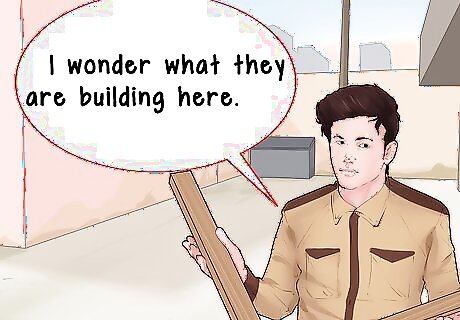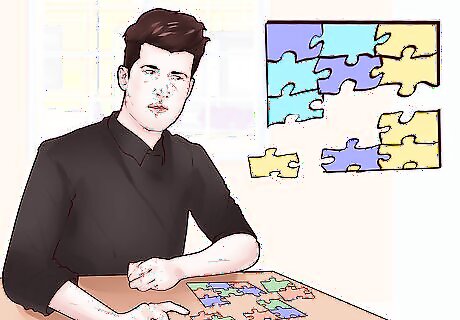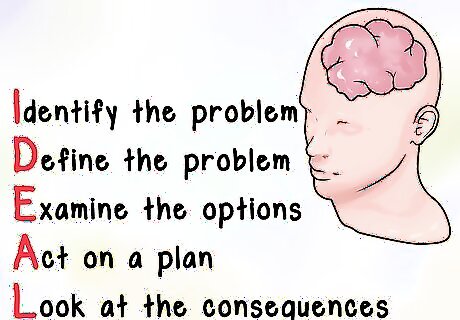
views
Changing Your Thought Process

Learn the seven techniques. Lateral thinking is a term that was coined by author Edward de Bono. Essentially, thinking laterally means to find new perspectives and new ways to address challenges. Many others have adapted and used de Bono's original principles, which were based on these seven techniques: Alternatives: Look for different ways to solve problems Focus: Train your brain to think more clearly Challenge: Think in nontraditional ways Random entry: Be open to different lines of thought Provocation: Turn a provocative situation into something useful Harvesting: Choose the best of your new ideas Treatment of ideas: Alter ideas to fit different scenarios

Be curious. A key component in lateral thinking is curiosity. An inquisitive mind is more likely to be able to adapt to the core principles of lateral thinking. In order to be able to think outside the box, you need to learn to spark your own curiosity. Take time to wonder. Don't just pass by a construction site, for example. Stop and think, "I wonder what they are building here. I bet you have to have a lot of different permits to build in this neighborhood." Try making a list of things you are curious about. You can keep a small notebook on you and jot down thoughts when you are out and about.

Ask questions. Creative (or lateral) thinking depends on your willingness to ask questions. Train your brain to start questioning information as you process it. You can apply this to things you read, watch, and conversations. For example, if a friend tells you that they are voting for a certain candidate, ask questions. You can say, "What factors are you basing that on? What is your opinion on climate change?" You can question things you read, too. For example, if you are reading an article about the decline of the bee population, ask yourself some questions like, "How could this impact the environment? What are some ways I could be part of a solution?"

Try puzzles. Lateral thinking won't happen over night. It will take time to train your brain. In addition to being curious and questioning, you can help the process by engaging in certain activities, like puzzles. Certain types of puzzles, such as brain teasers, are great for helping hone your problem solving skills. You can find puzzles online, or buy a book full of them. Logic puzzles are also great!
Thinking Laterally in Everyday Life

Use the IDEAL method of problem solving. Lateral thinking can make a big difference in your everyday life. Once you have started changing your mindset, you will begin to look at everyday issues with a new perspective. Combined with your other new skills, using the IDEAL method to solve problems is useful. IDEAL stands for: Identify the problem Define the problem Examine the options Act on a plan Look at the consequences

Tackle practical problems. Once you have learned the IDEAL method, you can apply it to practical problems. For example, maybe you are trying to figure out how to make your dog obey commands. You could apply lateral thinking to solve this issue. First, ask questions. You might say, "Why is my dog acting this way? Has something in his life changed? When did this start?" Then, apply the IDEAL method. Make sure to use creativity when brainstorming options!

Become a critical thinker. Critical thinking is a major component of being able to think laterally. Thinking critically means that you are evaluating information, asking questions, and looking at issues from different perspectives. There are ways to enhance your critical thinking skills. Work on clarifying the problem. For example, maybe you and your partner have not been getting along lately. Clarify the problem by examining what is really going on. Ask yourself questions such as, "Is the other person under a lot of stress at work? Is either of us focusing on our relationship?" Once you clarify the problem, you can further your critical thinking by gathering information and looking at the issue from all sides.

Practice creativity. Creative thinking is essential for applying lateral thinking to your everyday life. It may not come naturally to you. Try to actively train your brain to look for creative solutions for everyday problems. Brainstorm. For example, maybe you want to find money in your budget for a great vacation. Make a list of all of the ways you could save money or make more money. Be open to alternatives. Be willing to try some of the nontraditional ideas you come up with when you brainstorm. Ask for input. Have your friends and family help you come up with new ideas. Don't be afraid to try a new solution!

Keep a journal. Learning to think laterally is a process. Some days you may not feel like you are really "getting it". Try keeping a journal of your various thoughts each day. Choose a time each day to write in your journal. It could be in the morning, or right before bed. Make note of any challenges that you faced throughout the day. Write down the different approaches you used to solve the problem. Once a week, take time to read through your journal. You might be surprised at how much progress you are making!
Applying Lateral Thinking at Work

Ask "what if" questions. Lateral thinking can be a great asset as you work to advance your career or impress your boss. No matter what you job is, you will be more successful if you are able to demonstrate critical thinking and problem solving skills. You can start doing this by asking "what if" questions. Approach with this method. For example, if you are in sales, try asking, "What if a similar product comes on the market? How will we promote our product?" You could also try, "What if our sales drop? How will we adjust our approach?" By approaching problems with questions, you are opening yourself up to view all possibilities and options.

Find creative solutions. Thinking lateral can help you find innovative ways to solve problems. When faced with an issue, tap into your creativity. You can help your team by coming up with new ideas. Maybe your company is growing and you need new office space. You can think outside the box and come up with some great ideas. Start brainstorming. Write down anything that comes to mind such as, "New neighborhood? Build our own building? Share space with another company?" Flesh out the ideas that could work--and remember to be open to change!

Embrace challenges. Every job comes with challenges. Your boss will be impressed if you show that you are not intimidated when an issue arises. When problems come up, try saying, "This is a good opportunity for us to find some new solutions. Let's think creatively and find a way to make this a positive situation." Maybe you work for a non-profit. If you need to raise more fund, prove that you are up to the challenge. You could say, "How can we meet more members of the community? What if we all use our professional networks and reach out to new potential sponsors."

Demonstrate initiative. Your ability to think laterally will be one of your greatest assets. Don't wait until a problem arises to show off your skills! If you see an area that needs change, go for it. For example, you could try saying to your boss, "I notice our third quarter numbers are great. Do you have time this week to listen to some ideas I have about how to make them even better?" Use your meeting to show that you have thought critically and creatively about your plan.




















Comments
0 comment